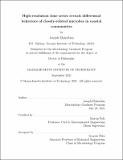| dc.description.abstract | Coastal plankton, primarily composed of heterotrophic bacteria, eukaryotic microalgae, and other small eukaryotes, have an outsized impact on global biogeochemical cycles. Understanding the forces that affect community assembly and dynamics through time is therefore important for our understanding of these cycles. From careful analyses of the genetics and behaviors of isolates we know that very closely related microbes can vary in their potential for growth, defense from predation, and ability to compete and cooperate for resources. However in surveys of the environment, most studies have focused on lower-resolution groupings of taxa, so little is known about how these differences between closely related microbes play out in the wild. In this thesis, I show that when viewed at high temporal, spatial, and genetic resolution, the coastal plankton community is highly dynamic. Making use of a 93-day time series collected from Nahant, Massachusetts, I analyze amplicons at single-nucleotide resolution. First, for the eukaryotic community I show that despite apparent stability at higher taxonomic levels, there is rapid turnover of the community at the sequence level, and that for sequences one nucleotide apart there is evidence for distinct ecologies. Second, in the bacterial community, I use a much more resolved genetic marker library to show that even when sequences emerge from the same species there is evidence for distinct dynamics during the time series. Taken together, these observations demonstrate a seemingly fractal diversity in the coastal ocean plankton, where the further one zooms in the more distinctions one can make between organisms. This dizzying diversity across temporal, spatial, and evolutionary scales may have previously unappreciated impacts on our understanding of these communities. | |

